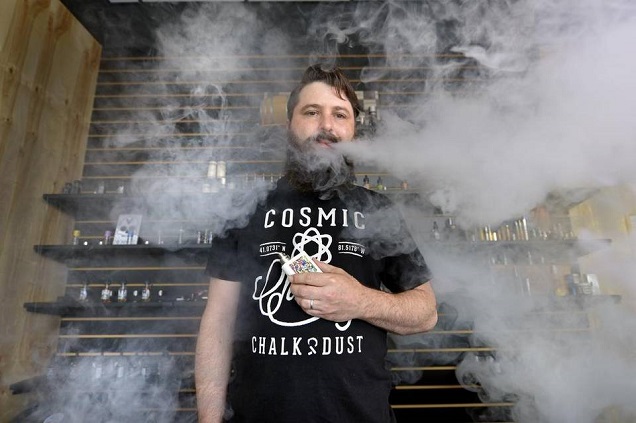
For those still nurturing a lifelong hatred for smoking, and in particular those who equate any form of nicotine consumption with smoking, e-cigarettes are a ghastly, disgraceful invention. “Do you know they still contain toxins?!” they ask, apparently unaware that any substance in sufficient doses is toxic and that e-cigarettes only contain tiny amounts of any potentially risky chemicals. “You’re still addicted to nicotine,” they say, sipping their fourth cup of coffee of the day. “There isn’t much evidence that those things even help you quit,” they add, willfully ignorant of the fact that they’re likely addressing somebody who’s already quit.
This type of attitude explains the desire by some of those in tobacco control to claim that we don’t even need e-cigarettes (even if the data suggests the opposite), and to look for any reason to cast doubt on the value of vaping. This is the reality we’ve been living for years: a product that all available evidence indicates does help people quit smoking and which has overwhelming support –even producing enthusiasm – from users, is being denigrated at every possible opportunity.
So, do we really need e-cigarettes? Are those in tobacco control right? The short answers are yes and no, respectively. E-cigarettes (and other forms of tobacco harm reduction) are immensely valuable, and the reason is very simple: we’re dealing with smokers here.
“Don’t Smoke, It’ll Kill You.”

Smokers’ Response: Start Smoking
This is the fundamental point. Think about what it actually means for somebody to start smoking in the modern age. You can’t even buy a pack of cigarettes without being reminded of the multitude of horrendous outcomes that will surface if you smoke. It would be completely and utterly unfeasible for a non-smoker to be unaware of the risks. But people still start.
The reason? It’s not pleasant, but the clear implication is that they don’t really care all that much. Smoking is an enjoyable activity, and this is more important to the just-starting smoker than some far-off potential risk of lung cancer. Smokers, by the very fact that they start smoking, are not particularly concerned about all the warnings and graphic images of blackened lungs and tumor-ridden corpses; which is why the pictorial warnings on cigarette packs in many countries have been largely useless. Smoking is effectively raising a middle finger to all of those people trying to tell you how you should live, what you should do, what you should eat and what you should avoid at all costs.
Like it or not, smoking is an expression of freedom. It’s a public display that pleasure is more important to you than some far-off future risks. Incidentally, this is probably why smokers also have worse diets, exercise less, drink more alcohol and take more drugs than non-smokers too.
“Medicine is the Most Effective Approach for Quitting.”

Smoker’s Response: Don’t Take it
Eventually, though, the pleasure of smoking does start to wane. You feel like you’re coughing up hunks of lung every morning, and think “OK, maybe I should try to quit before I start growing tumors.” For those who’ve been trying to get smokers to quit, this is the opportunity they’ve been waiting for. The reckless abandon must be gone now, and we can get them interested in some of the most experimentally-supported quitting approaches. “Try something like Chantix,” they say, “it increases your odds of quitting by two to three times.”
For a smoker, though, going to the doctor and taking actual medicine for the sake of avoiding smoking seems excessive. So they don’t really take the medicine very often: 70 percent of smokers trying to quit don’t use any medications, and almost 89 percent don’t bother with Chantix. Similarly, bupropion increases your odds of quitting by about 82 percent, but only a measly 3 percent of smokers actually try it.
In short, smokers don’t really listen to the advice offered by organizations like the CDC when it comes to quitting: the approaches clearly don’t appeal.
“Go to Counseling, it Helps With Quitting!”

Smoker’s Response: Don’t Go
From a psychological perspective, smokers are struggling with an addiction, and the solution to this problem – as it is with other addictions – is assumed to be counseling. Studies suggest that this assumption is basically correct: individual counseling improves quit-rates by about 40 percent, group therapy helps too, counseling in addition to medication outperforms usual care or less intensive behavioral support (increasing odds of quitting by about 82 percent) and even receiving brief advice or talking to a quit-line makes quitting more likely. The best approach, in terms of the evidence, is to use both medication and counseling.
But, as we’ve already learned, smokers have a habit of not doing what’s best for them. The previously-quoted study found that just 6 percent of smokers trying to quit used counseling – or, in more relevant terms, 94 percent didn’t bother with it. Other studies find slight differences, but still report that between 91 and 96 percent of smokers don’t use any form of counseling.
Why? Because attending counseling to quit smoking seems even more excessive than taking a pill. As a smoker, who has already made the decision to throw caution to the wind and start doing something unilaterally called the leading preventable cause of death in the world, would you really want to sit on a couch and whine about how you smoke to cope with stress? Would you really want to keep a “craving journal”? Smoking is a brash, reckless activity; meticulously documenting your cravings and getting professional support to help you stop doing something most people manage perfectly fine without (while obviously beneficial to many people) seems comparatively pathetic.
Of course, counseling isn’t really about sitting on couches and talking your problems through isn’t whining, but to a smoker, it can easily seem unnecessary and self-indulgent (but not in the fun way).
“Well, At Least Use a Patch…”

Smoker’s Response: I’ll Go Cold Turkey
Any final attempt to get smokers to try some form of support if they want to quit is pretty much hopeless. The reality is that most smokers try to quit “cold turkey,” with estimates usually suggesting that around two-thirds do so. The reasoning behind this is effectively what we’ve been discussing: smokers don’t really seem all that interested in using medical treatments or attending counseling to quit smoking. Surely, they think, I can just not smoke: it’ll be easy.
Except it isn’t. Almost 93 percent of those who try to quit cold turkey will fail. In estimates taking into account the “control” portion of quitting studies (i.e. smokers who may have been expecting some genuine treatment), this failure rate can be even higher, with between 95 and 97 percent of cold turkey quitters failing, ordinarily within the first eight days. The withdrawal symptoms and the psychological realities of overcoming addiction win the fight, and it’s very easy to go out to the store and pick up another pack of cigarettes.
“Come On, Try the Patch…”

Smoker’s Response: It’s Shit
Patches are the most common aid to quitting smokers actually use (at least among approved strategies), with the 2000 to 2010 National Health Interview Surveys suggesting that around 14.6 percent of quit attempts involve patches. So, after our fictional smoker has experienced the disheartening failure in their attempt to quit cold turkey, he or she might decide to give the patch a try. At least there’s still nicotine in there.
The problem is that it’s pretty shit. Stick a band-aid-looking thing on your arm and be treated with a low dose of nicotine delivered too slowly. Although it’s used more than most other approaches, and the evidence does back it as a more effective method than cold turkey, the ultimate quit-rates are still very underwhelming: it only adds about 2 to 3 percent onto the basic cold turkey quit-rate of 3 to 5 percent, meaning that at least 92 percent of attempts result in failure. If bought over the counter, nicotine replacement therapy might be even worse than cold turkey quitting.
What Now?
So, bearing in mind the mentality of a smoker – the sort of person who does something that has a substantial chance of killing them, shuns the most evidentially-supported quitting methods and is probably feeling a little disheartened with the options available to them – what comes next? Does the smoker decide that – even though they gave into the conventional advice with the patch, but failed – it’s worth re-evaluating their attitude to medication or counseling? Some undoubtedly will, but many others won't.
This whole situation is why the majority of smokers want to quit – having realized that smoking, although sometimes fun, isn’t the best of ideas – but ultimately can’t do so, even if they make a genuine effort to. Even if a smoker uses an approved method, the prospects are still pretty grim: for instance, Chantix might increase quit-rates (compared to a placebo) by about three times, but that only equates to a success rate of less than 15 percent, meaning a failure rate of over 85 percent.
Why We Need E-Cigarettes

This is when e-cigarettes really start to look attractive. To the smoker, it looks like the best of both worlds: a smoking-like habit that provides nicotine and probably won’t kill you. It’s all the benefits of quitting except that you get to keep the nicotine and enjoy your habit.
Even better, there are still a bunch of hysterical prohibitionists in the tobacco control community claiming that it’s not a good idea to vape because being about 20 times safer than smoking doesn’t mean it’s completely safe. For one, it’s clear that smokers don’t really care all that much about doing something even substantially risky, much less something that is possibly a little bit risky. “But,” the opponents of vaping continue, “there’s not much evidence they even help you quit!”
Well, another thing we’ve learned about smokers is that they’re hardly the best at picking evidence-based methods for quitting. Granted, the Cochrane Review of the evidence on e-cigarettes for quitting smoking graded the evidence poorly because there was only a small number of trials and most had small numbers of participants (in contrast to the dozens upon dozens of trials for other methods) – and this seems like a fair analysis – but it did suggest that e-cigs are effective, non-the-less.
The crucial point throughout this fictional journey from taking up smoking to trying to quit is that how much an intervention brings down smoking rates is completely dependent on how many people use it. If there was a wonder-drug that guaranteed quitting smoking, but only 1 percent of smokers who tried to quit used it, since about half of smokers try to quit in any given year, it would only reduce the number of smokers by a pathetic 0.5 percent per year. If you could get every smoker to try it, smoking would be done-for, but it accomplishes next-to-nothing if they don’t want to use it.
So, even in the absence of robust, long-term safety data and 100 clinical trials of their effectiveness for quitting, the appeal of vaping to smokers is why we need it. Even if later-generation e-cigs are also found to be about as effective as patches, if they’re used by more smokers, they will bring down the smoking rate a lot more.
In 2014, about 32 percent of daily smokers and 34 percent of non-daily smokers were current vapers, and over 60 percent of both groups had tried vaping. Other research shows that the vast majority of vapers get started with the aim of quitting or reducing smoking, so it’s clear that this is already happening with vaping. This should be obvious, since sites like this one simply don’t exist for other quitting approaches (unless there are a bunch of nicotine gum review sites and user forums populated by legions of enthusiastic “chewers” that I’ve been missing).

Dear Public Health and Tobacco Control: Please Think About Smokers
In the name of fairness, the reality is that each method that’s been mocked in this article does also help smokers quit. Some smokers won’t be like our fictional smoker: they will try medication and counseling, and many of them will successfully quit, and others will find the patch to be a life-saver. However, the slow decline of the smoking rate shows that this isn’t really enough.
So, to anybody in public health or tobacco control who’s reading (unlikely to be many, admittedly, because who cares what a vaper thinks, right?), try to think about this issue from the perspective of a smoker. As Clive Bates points out, they are the “public” in public health, and if you really want to help smokers, you should make an effort to understand what motivates them.
You shouldn’t be criticizing vapers as still addicted; you should be congratulating them for once being smokers but making the right decision and at least trying to kick the “dangerous” part of their dangerous habit. And you shouldn't be discouraging smokers who express interest in quitting smoking by vaping because of some limply-supported hypothetical concerns; you should be clearly communicating the fact that vaping is almost certainly much safer than smoking, and that switching is a great idea for anyone unable to quit or who just doesn't want to.
Vaping isn’t likely to be completely safe, and it might not even turn out to be hugely effective for quitting within the confines of clinical trials, but it undeniably appeals to smokers way more than anything else they have available. That is why we need vaping. And that is why you should support it wholeheartedly, because they think everything else you have for them sucks.

